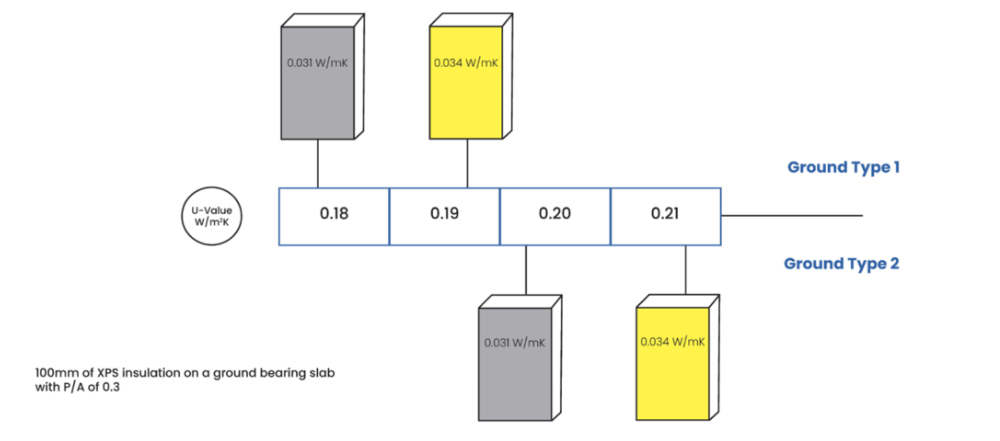The hidden subtleties of U-Value calculations
Calculating prospective U-Values is a routine part of the building design process, so routine that you could be forgiven for not giving all that much thought to the intricacies of each and every calculation.
However, the slightest of changes to certain variables can have a significant impact on the final result and mistakes made in the design stages can come back to haunt us.
Contents |
[edit] The impact of ground types
Let us consider the case of ground-bearing floors – the thermal properties of the underlying ground can have a notable impact on the overall thermal performance of a buildup. It is therefore important to ensure that the U-Value calculations for competing insulation products have been compiled using the same ground type to allow you to make an informed decision. To this end, you should always provide the ground type (if known) when requesting a calculation to ensure that the resulting U-Value is most accurate. BS EN ISO 13370:2017 states that there are three categories of ground type:
The standard is clear that when the ground type is unknown it should be assumed to be category 2. While there is a swathe of fantastic tools on the market to help produce U-Value calculations, some of them actually default to using category 1, so those performing the calculation need to make sure that this is changed when a prospective customer has not specified a ground type. To demonstrate the importance of using a consistent ground type across calculations, lets look at an example build-up involving 100mm of XPS insulation on a ground bearing slab with a P/A of 0.3. In this scenario, using an XPS board with thermal conductivity of 0.031 W/mK results in a U-Value of 0.20 W/m2K when calculating for ground type 2, meanwhile a board with thermal conductivity of 0.034 W/mK can achieve a U-Value of 0.19 W/m2K if we instead use ground type 1; unless you were checking for the difference in ground type you would think that the board with higher thermal conductivity was the superior solution! (see diagram above)
[edit] What elements should be included in the calculation?
BS EN ISO 13370:2017 is also somewhat ambiguous on how to account for the thermal properties of some elements of a ground bearing floor. While it is explicit that the hardcore below a concrete slab should not be included, it states the “thermal resistance of a dense concrete slab may be neglected”, leaving it to the individual performing the calculation to decide. This decision is quite a significant one, as typically the inclusion or exclusion of the concrete slab’s thermal resistance will cause a variance of 0.01 to 0.02 W/m2K in the final U-Value. The 2019 edition of Conventions for U-Value Calculations (BRE BR443) provides best practice advice to complement the standard. At first it is quite definitive, stating that “It is recommended for most calculations that dense floor slabs (ρ ≥ 1800 kg/m³) and floor coverings such as vinyl or carpets are not included in the calculation”, but frustratingly, it then immediately reintroduces the ambiguity of the standard by saying “but it is permissible to include them if their properties are adequately defined.” It is therefore important to check exactly what elements have been included in individual U-Value calculations before trying to compare them.
[edit] The need for a common standard
These are just a couple of examples demonstrating how difficult it can be to compare U-Value calculations when trying to specify insulation. We need to start calculating U-Values with a consistent and transparent methodology that will allow specifiers to compare the performance of different insulation products quickly and easily.
This article appears in the AT Journal no 148, winter 2023 as "The hidden subtleties of U-Value calculations" and was written by Joan Ferrer, Commercial Director UK & I RE, Ravago Building Solutions.
--CIAT
[edit] Related articles on Designing Buildings
- Accredited construction details ACDs.
- Air tightness in buildings.
- Assessing the effects of thermal bridging at junctions and around openings.
- Building fabric.
- Building performance.
- Cavity wall.
- Cavity wall insulation.
- Co-heating test.
- Computational fluid dynamics.
- Conduction
- Conventions for calculating linear thermal transmittance and temperature factors.
- Conventions for calculating linear thermal transmittance and temperature factors.
- Conventions for U-value calculations (BR443 2e 2019).
- Double glazing v triple glazing.
- Emissivity.
- Emission rates in the building regulations.
- Floor insulation.
- Free U-value calculators.
- g-value.
- Heat loss.
- Heat transfer.
- Insulation.
- Insulation for ground floors.
- Insulation specification.
- Interstitial condensation.
- k-value.
- Limiting fabric parameters.
- Mould growth.
- Reducing thermal bridging at junctions when designing and installing solid wall insulation FB 61.
- Roof insulation.
- R-value.
- Solid wall insulation.
- Standard Assessment Procedure SAP.
- Thermal admittance.
- Thermal bridge.
- Thermal bridging and the Future Homes Standard.
- Thermal comfort.
- Thermal imaging to improve energy efficiency in building design.
- Thermographic survey.
- Thermal mass.
- Thermal resistance.
- U-values
- U-value conventions in practice: Worked examples using BR 443.
- U-What?
- What do design professionals need to know about U-value calculation conventions?
Featured articles and news
RTPI leader to become new CIOB Chief Executive Officer
Dr Victoria Hills MRTPI, FICE to take over after Caroline Gumble’s departure.
Social and affordable housing, a long term plan for delivery
The “Delivering a Decade of Renewal for Social and Affordable Housing” strategy sets out future path.
A change to adoptive architecture
Effects of global weather warming on architectural detailing, material choice and human interaction.
The proposed publicly owned and backed subsidiary of Homes England, to facilitate new homes.
How big is the problem and what can we do to mitigate the effects?
Overheating guidance and tools for building designers
A number of cool guides to help with the heat.
The UK's Modern Industrial Strategy: A 10 year plan
Previous consultation criticism, current key elements and general support with some persisting reservations.
Building Safety Regulator reforms
New roles, new staff and a new fast track service pave the way for a single construction regulator.
Architectural Technologist CPDs and Communications
CIAT CPD… and how you can do it!
Cooling centres and cool spaces
Managing extreme heat in cities by directing the public to places for heat stress relief and water sources.
Winter gardens: A brief history and warm variations
Extending the season with glass in different forms and terms.
Restoring Great Yarmouth's Winter Gardens
Transforming one of the least sustainable constructions imaginable.
Construction Skills Mission Board launch sector drive
Newly formed government and industry collaboration set strategy for recruiting an additional 100,000 construction workers a year.
New Architects Code comes into effect in September 2025
ARB Architects Code of Conduct and Practice available with ongoing consultation regarding guidance.
Welsh Skills Body (Medr) launches ambitious plan
The new skills body brings together funding and regulation of tertiary education and research for the devolved nation.
Paul Gandy FCIOB announced as next CIOB President
Former Tilbury Douglas CEO takes helm.
UK Infrastructure: A 10 Year Strategy. In brief with reactions
With the National Infrastructure and Service Transformation Authority (NISTA).


























